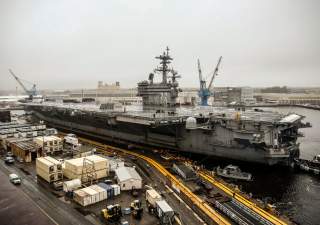Problem: America Can't Build and Repair Ships Quickly Anymore
A huge industrial problem.
Key point: America needs a better industrial and shipyard capacity if it is to win another major war.
The U.S. naval industrial base is in bad shape. There are too few shipyards and they work too slowly to quickly expand the fleet. In wartime, they would struggle to repair battle-damaged ships.
That’s the dire conclusion that William Hawkins, a former Congressional researcher, reached when he studied government shipbuilding reports. Hawkins explained his alarm in an article in the August 2019 edition of the U.S. Naval Institute’s Proceedings.
Hawkins pored through two recent U.S. Navy reports to Congress. Annual Long-Range Plan for Construction of Naval Vessels for Fiscal Year 2020 and Long-Range Plan for Maintenance and Modernization of Naval Vessels for Fiscal Year 2020.
“Both reports present an industrial base at the limit of its capacity, at best,” Hawkins wrote. Yards have barely enough capacity to grow the fleet to its goal of 355 front-line ships, up from around 290 currently in service.
“Shipbuilders seem confident they can produce warships on the schedule the Navy has drawn up, but that is largely because the pace of construction is no better than moderate,” Hawkins pointed out. “The 355-ship target will not be reached until 2034; four presidential and seven Congressional elections will pass before then, presenting risks to continuity.”
The Navy owns four shipyards. Four private firms between them own another seven yards. Eleven yards in total for a fleet that could grow to 355 ships, not counting scores of auxiliaries as well as Coast Guard vessels.
“In the face of the construction demands, capacity to repair battle damage resulting from combat in a distant theater such as the South China Sea seems to be lacking,” Hawkins wrote. “The Maintenance and Modernization report calls for expanding beyond the current 21 dry docks on the U.S. Pacific coast merely to reduce current backlogs in the normal routine. When something off schedule occurs, extraordinary measures have to be taken.”
Hawkins cites the example of the destroyer USS Fitzgerald as a cautionary example. Fitzgerald collided with a merchant vessel off the Japanese coast in June 2017. The Arleigh Burke-class destroyer suffered heavy damage.
“The warship first limped to Japan for evaluation before being sent back to the United States for repairs,” Hawkins wrote.
But she could not be dealt with at any of the Pacific dockyards; she had to be carried to a dry dock at Ingalls Shipbuilding in Pascagoula, Mississippi. The Ingalls facility is the leading construction site for the Arleigh Burke–class, having built 30 of them with more under contract.
At the time, the Navy stated, “Only [Ingalls] has the available capacity to restore USS Fitzgerald to full operational status in the shortest period of time with minimal disruption to ongoing repair and new construction work.” ...
Houston-based Patriot Shipping provided the heavy-lift vessel needed to carry the Fitzgerald home. She did not reach Pascagoula until January 2018 and did not leave the dry dock there until mid-April 2019, 22 months after the collision.
There are plenty of other cautionary examples, Hawkins pointed out. “When the USS Cole (DDG-67) was damaged in suicide attack in Aden in October 2000, she also had to be transported back to the United States for repairs, on a Dutch heavy-lift vessel. The destroyer did not leave its Pascagoula dry dock until September 2001, a shorter stay than the Fitzgerald only because the damage was not as extensive.”
Then there was the destroyer USS John S. McCain, which collided with a merchant ship near Singapore in August 2017. “She was repaired in Japan, where she is home-ported, rather than transported back to the United States,” Hawkins wrote.
The destroyer remained in a Yokohama dry dock from January 2018 until late November, 15 months after the accident. In any Pacific Rim naval war, the hope is that Japan will be an active ally whose facilities would be available to U.S. warships. However, battle-damaged Japanese ships could be competing for repair capacity, and Japan’s yards might come under attack given their proximity to the combat theater.
Each of these destroyer incidents involved only one ship, and none was especially large. How many warships might be damaged in a short period during a war with a major adversary? And might they not include larger ships: cruisers, amphibious assault ships and aircraft carriers?
Hawkins concluded by quoting a 2018 report from the National Defense Strategy Commission. “Against an enemy equipped with advanced anti-access/area-denial capabilities, attrition of U.S. capital assets—ships, planes, tanks—could be enormous.”
And owing to a dearth of shipyards, the Navy might not be able to repair the damage in time to make a difference in the conflict.
David Axe serves as Defense Editor of the National Interest. He is the author of the graphic novels War Fix, War Is Boring and Machete Squad. This first appeared in August 2019.
Image: DVIDShub.

